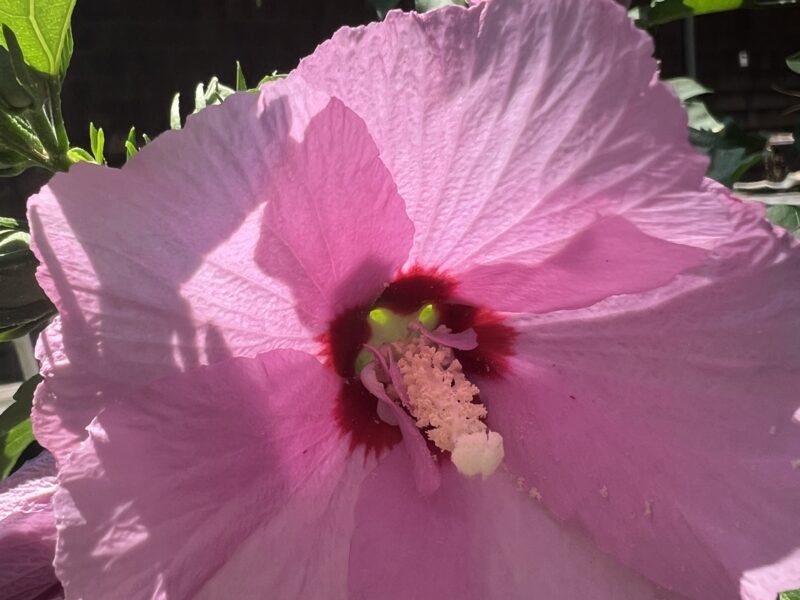

A few days after my last column was published, shedding light on the mysterious lives of miner bees, a friend asked if miner bees were pollinators, like honeybees, and how did that all work?
Her question made me realize that I may take too much for granted here, in terms of what readers know about many things bee-related. Pollination, for example. Anyone who doesn’t live in a cave has likely heard about the importance of pollinators, but how many really understand what pollination entails, and how bees figure into it? Let’s dive in.
Pollination is essentially the botanical version of sex. So, when a mommy and daddy plant love each other very much …
OK, it’s not quite like that. But plants do have male and female components, and bees and other pollinators are crucial in making sure the products of each end up in the right place so those plants can produce seeds or fruit, which feed the world and generate more plants.
The stamen is the male part of a flower. A stamen pretty much consists of several stalks, each supporting an anther, which produces pollen, the male reproductive cells. You can see six anthers in the stargazer lily in this photo, all covered in orange pollen.
In the middle of those anthers is the stigma, the small conical bit at the tip of the style. The stigma is part of the pistil, which comprises the female components of a flower. It’s the opening at the top of the style, a tube that leads down to the ovary. The ovary contains ovules, female reproductive cells. When pollen from the same kind of plant finds its way down the style, fertilization occurs, and a new generation is born.
Complicating the process is the fact that there are basically two kinds of plants: self-pollinating and cross-pollinating. A self-pollinating plant grows flowers with both male and female components and can pollinate, or fertilize, itself. The stargazer lily is a good example of a self-pollinator. Of course, lilies also reproduce by making more bulbs, so pollination isn’t critical to their survival, but it’s always good to have a backup plan!
Cross-pollinating plants produce flowers with either male or female components, and require help getting the pollen from the anther of the male flower to the stigma of the female flower. Within the cross-pollination category are two distinct varieties:
Monoecious plants produce separate male and female flowers. Squash plants are a common example. Male flowers generally bloom earlier and in much larger numbers than females and contain several pollen-covered anthers. The female flower features a swollen stem in the middle that looks like a tiny baby squash — and if it is successfully pollinated, will ultimately grow into a ripe squash ready to harvest.
Dioecious plants produce only male or female flowers, making cross-pollination a bit trickier, since the pollen from the male must find its way to the stigma of the female on a totally different plant. Some willows and hollies are dioecious.
But how do all these plants attract the pollinators they need to survive? Well, this is where our superhero pollinators come in — a boost to monoecious plants and essential for their dioecious cousins.
Most flowers produce nectar, a sweet liquid with a single purpose — to lure pollinators — including bees, butterflies, hummingbirds, even dreaded wasps. Some pollinators are drawn to only one type of flower, but most, including honeybees, are generalists, happy to visit any tasty bloom they can find.
While those foragers are enjoying a sweet snack, they’re also drawing bits of pollen from the flowers’ anthers onto themselves. When they move from blossom to blossom, they carry that pollen with them, and some of it drops off on the next flowers they visit. If one of those flowers is the same species and happens to be female, there’s a good chance some of that pollen may end up in the stigma, resulting in fertilization.
Some pollinators also collect pollen on purpose. In the case of honeybees, they stash it into their corbiculae, or pollen pockets, little concave areas at the top of their hind legs. Pollen is brought back to the hive, where the bees use it as a source of protein. Mixed with just enough honey to make it sticky, the pollen is packed into cells in the hive’s comb.
Over the course of a single day, a honeybee might gather nectar from as many as 60 flowers, over a five-mile radius. The bee’s honey stomach, essentially a nectar storage pouch, can hold about 75 milligrams of nectar (think of a single drop from an eyedropper). That is also roughly what a honeybee weighs. Imagine traveling five miles carrying your clone.
When a honeybee gets back to the hive with the nectar it’s gathered, it regurgitates that nectar, now partially digested, onto worker bees that are tasked with storing and processing it. Nectar is generally about 80 percent water. The bees add digestive enzymes to the raw nectar and store it in wax honeycomb. Some worker bees have the job of fanning the honey-to-be, reducing the moisture content to around 18 percent. Once the moisture content is low enough to keep the honey from fermenting, the honeycomb is capped with wax. Capped honey has an unbelievable “use-by” date — honey has been found in ancient Egyptian artifacts, still perfectly edible.
A honeybee lives about six weeks, spending the last two weeks of that foraging for honey. Over the course of that two weeks, one honeybee will gather enough nectar to produce about 1/12th of a teaspoon of finished honey. So next time you add a spoonful of honey to your tea, give a thought to the thousands of bees that made it possible.
 More Posts from Lisa Daffy
More Posts from Lisa Daffy